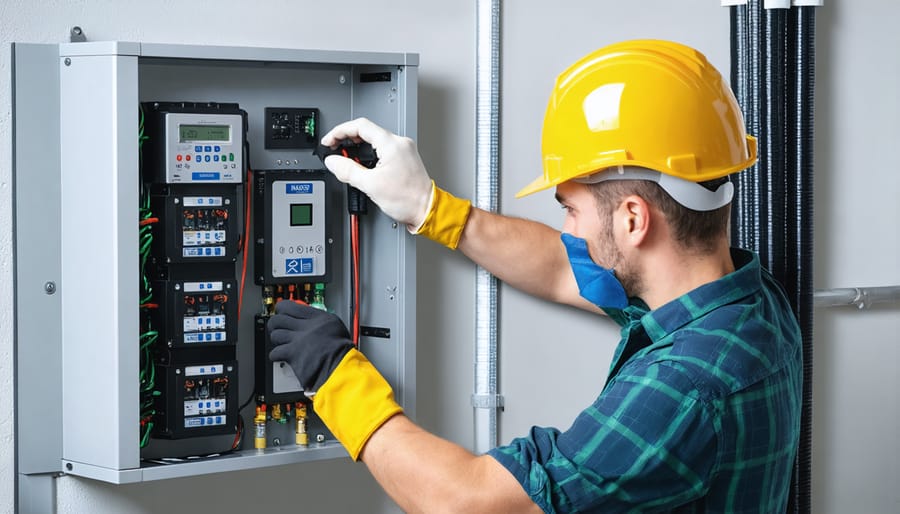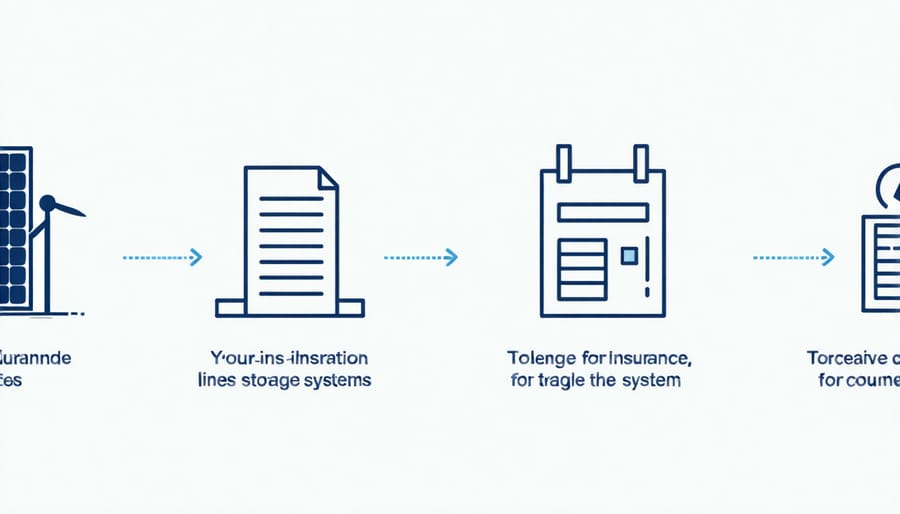Qualified battery storage technology revolutionizes home energy management, offering homeowners a powerful solution to rising electricity costs and grid independence. As solar installations surge across America, sophisticated battery systems have emerged as the critical link between energy generation and optimal consumption. These advanced storage solutions, when properly qualified and insured, not only provide reliable backup power during outages but also enable households to maximize their renewable energy investment through strategic energy management.
Beyond mere convenience, qualified battery storage systems represent a crucial advancement in residential energy infrastructure. These systems must meet rigorous safety standards, technical specifications, and installation requirements to earn qualification status – essential factors for both insurance coverage and optimal performance. For homeowners navigating the transition to sustainable energy, understanding these qualification requirements ensures proper system protection while unlocking substantial energy savings and environmental benefits.
This dynamic technology transforms ordinary solar installations into complete energy management systems, offering peace of mind through reliable backup power while maximizing the financial returns on renewable energy investments. Smart integration with existing home systems enables unprecedented control over energy consumption patterns, leading to enhanced efficiency and reduced utility costs.
What Makes a Battery Storage System ‘Qualified’?
Safety Certifications and Standards
Safety certifications play a vital role in ensuring your battery storage system is reliable and insurance-compliant. The most important certification to look for is the UL 9540 listing, which validates that the battery system meets strict safety and performance standards. This certification covers everything from fire safety to electrical performance.
For home installations, your battery system should also comply with IEEE 1547 standards, which ensure proper grid integration and safety protocols. These standards are especially important for systems connected to the power grid and help prevent electrical hazards.
Insurance companies typically require these certifications before providing coverage. You’ll want to check for the CE mark (for European standards compliance) and IP ratings that indicate protection against dust and water. The National Electrical Code (NEC) compliance is another must-have for residential installations.
When shopping for a battery system, make sure to request documentation of these certifications from your installer. Keep copies of all safety certificates and compliance documents for your insurance records. This documentation not only helps with coverage but also ensures your system meets local building codes and regulations.

Installation Requirements
Professional installation of battery storage systems is essential for both safety and insurance coverage. Your system must be installed by a certified electrician who’s familiar with local building codes and energy storage systems. They’ll ensure proper mounting, wiring, and integration with your home’s electrical system.
Before installation, obtain all necessary permits from your local authorities. Your installer should provide detailed documentation, including system specifications, installation certificates, and warranty information. Keep records of regular maintenance and any modifications to the system.
For insurance purposes, you’ll need to provide:
– Professional installation certification
– Equipment warranty documentation
– Compliance certificates for local building codes
– Safety inspection reports
– Detailed system specifications
– Maintenance records
Make sure your installer follows manufacturer guidelines and uses approved mounting hardware and safety equipment. The installation area should be clean, well-ventilated, and protected from extreme temperatures. Your battery system should also include proper safety features like emergency shut-offs and monitoring systems.
Remember to inform your insurance provider about the installation and confirm coverage requirements before proceeding with the project.
Insurance Coverage Types for Battery Storage

Home Insurance Integration
Installing a qualified battery storage system can significantly impact your homeowners insurance, and it’s essential to understand how these systems fit into your existing coverage. Most standard home insurance policies can be adapted to include battery storage systems, but you’ll need to inform your insurance provider about the installation.
Many insurance companies now recognize battery storage as a home improvement that adds value to your property. When properly installed by certified professionals, these systems typically fall under your policy’s dwelling coverage. However, it’s important to review your policy limits and ensure they adequately cover the full value of your battery system.
To maintain proper coverage, document your battery storage installation with photographs, installation certificates, and maintenance records. Some insurers may require specific safety certifications or professional installation to provide coverage. They might also offer discounts for systems that include advanced safety features or smart monitoring capabilities.
Remember to update your policy before installation begins. Most insurance providers will work with you to adjust your coverage appropriately, ensuring your investment is protected against potential risks like electrical fires, weather damage, or theft. Some companies even offer specialized renewable energy endorsements that provide enhanced protection for your entire solar and battery storage system.
Specialized Coverage Options
When protecting your battery storage system, specialized insurance options go beyond standard home insurance coverage limits. Many insurance providers now offer tailored endorsements specifically designed for renewable energy systems, including battery storage technology.
These specialized policies typically cover risks such as equipment breakdown, power generation loss, and environmental damage. Some insurers provide all-in-one renewable energy packages that bundle coverage for both solar panels and battery systems, often including protection against theft, vandalism, and natural disasters.
Key features to look for in specialized coverage include:
– Replacement cost coverage for the latest battery technology
– Protection against power surge damage
– Coverage for business interruption if you participate in grid services
– Environmental cleanup protection
– Professional installation and maintenance warranties
Many providers also offer “green upgrade” coverage, which ensures you can replace damaged equipment with more energy-efficient models, even if they cost more than the original installation. Some policies include additional living expenses coverage if system failure forces you to temporarily relocate.
To find the best coverage, work with insurance providers who specialize in renewable energy systems and understand the unique aspects of battery storage technology. They can help customize a policy that protects both your investment and the environment.
Protecting Your Investment
Documentation Requirements
To ensure proper insurance coverage for your battery storage system, you’ll need to maintain several essential documents. Start with your installation certificate from a certified technician, which should include detailed specifications of your system and confirmation that it meets local building codes. Keep a copy of your battery system’s warranty documentation, technical specifications, and safety certifications from the manufacturer.
You’ll also need to maintain records of regular maintenance checks and any repairs performed on the system. Many insurance providers require an annual inspection report from a qualified professional to maintain coverage. Make sure to document your system’s UL certification number and keep photographs of the installation, including safety features and warning labels.
For tax purposes and rebate claims, preserve all purchase receipts, invoices, and documentation of any applicable energy credits or incentives. Create a digital backup of all these documents and store physical copies in a safe, easily accessible location. Remember to provide copies to your insurance provider during the initial coverage setup and any policy renewals.
Finally, maintain an updated home electrical system certificate that shows your battery storage system is properly integrated with your home’s power infrastructure.

Maintenance Standards
To maintain your qualified battery storage system’s status and insurance coverage, regular maintenance and inspections are essential. Schedule professional inspections at least once a year to check the battery’s performance, connections, and safety systems. Keep detailed maintenance records, including dates of inspections, any repairs made, and system performance metrics.
Clean the battery enclosure regularly to prevent dust accumulation and ensure proper ventilation. Monitor the battery management system (BMS) readings monthly to catch potential issues early. Most modern systems include smartphone apps that make this monitoring simple and convenient.
Replace any damaged components promptly using manufacturer-approved parts. Many insurance policies require this to maintain coverage. Keep the area around your battery storage system clear of debris and maintain proper clearance distances as specified in your system’s manual.
Check your warranty terms carefully, as some maintenance tasks must be performed by certified technicians to keep the warranty valid. Most manufacturers recommend a professional system check every 2-3 years, even if no issues are apparent. Following these maintenance standards not only keeps your system qualified but also maximizes its lifespan and efficiency.
Common Insurance Pitfalls
When insuring your battery storage system, be aware of several common pitfalls that could affect your coverage and peace of mind. First, don’t assume your existing home insurance automatically covers your battery system – many standard policies exclude or limit coverage for renewable energy equipment without specific endorsements.
Another frequent oversight is underinsuring the system by only considering the hardware costs. Remember to account for installation expenses, permits, and potential revenue loss if the system fails. Some homeowners also forget to update their coverage as they upgrade or modify their systems, leaving gaps in protection.
Be cautious of insurance providers who lack experience with battery storage technology. They might impose unnecessary restrictions or charge excessive premiums due to misunderstanding the risks involved. Always work with insurers who have a track record in renewable energy systems.
Pay attention to warranty exclusions and maintenance requirements. Some policies become void if you don’t follow manufacturer-specified maintenance schedules or use unauthorized repair services. Also, verify that your policy covers both property damage and liability protection in case your system affects neighboring properties.
Lastly, don’t forget to document everything. Keep detailed records of your system’s specifications, maintenance history, and any modifications. This documentation proves invaluable when filing claims or demonstrating proper system care to your insurer.
As we’ve explored throughout this article, qualified battery storage technology plays a vital role in modern home energy systems, and protecting your investment through proper insurance coverage is equally important. By ensuring your battery storage system meets qualification standards and is properly insured, you can enjoy the benefits of energy independence with peace of mind.
Remember to work with certified installers, maintain detailed documentation of your system’s specifications, and regularly review your insurance policy to confirm adequate coverage. Many insurance providers now offer specialized coverage options for renewable energy systems, acknowledging the growing popularity of home battery storage solutions.
Taking these proactive steps not only protects your investment but can also lead to potential savings through reduced premiums and increased energy efficiency. As battery storage technology continues to evolve and become more accessible, maintaining proper insurance coverage will remain crucial for homeowners embracing sustainable energy solutions.
Stay informed about your policy requirements, keep up with regular maintenance, and don’t hesitate to consult with insurance professionals who specialize in renewable energy systems. Your battery storage system is an investment in both your home’s future and the environment – protecting it properly ensures long-term benefits for years to come.









